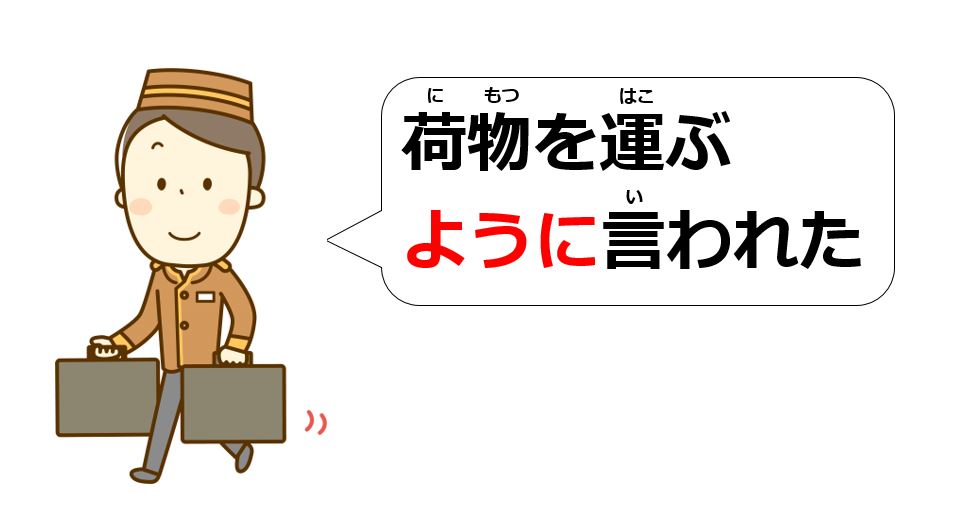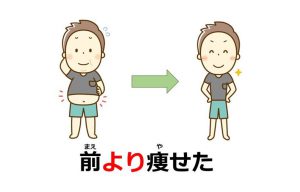Last time, you learned how to use 行く and 来る as helping verbs like 学校まで走っていきます (I will run and go to school). Now, you can express motion of subjects, motion of objects, and a time flow. Then, if you would like to say “I heard that you would run and go to school,” what should you say? In this lesson, you will tackle how to express quotation.
Explanation for How to Express Quotation in Japanese
| Table of Contents と: Generic Quotation と: Defining という with Relative Clauses ように: Quotation for Requests and Commands ように: Quotation for Generic Things |
First of all, let’s clarify what we mean by “quotation.” This literally means to quote what someone said, e.g. he said “I can speak Japanese,” or he said that he can speak Japanese. We will try to think the usage more broadly here. We can say that the structure of the sentence: “He thinks he can speak Japanese” is the same. In fact, both of them can be expressed by using the same sentence pattern in Japanese. Therefore, we will learn them together. Note: Japanese have the quotation marker 「 」 which is equivalent to the English “ ”, but there is no particular situation where you have to use it.
と: Generic Quotation
| 田中さんは | 明日アメリカに引っ越すと | 言った / 言いました |
| Topic / Subject | Noun Clause: Quotation | Verb |
| Tanaka-san said “[I] would move to the US tomorrow.” | ||
This is a basic sentence pattern. You can express quotation by placing と after noun clauses. Please pay attention to omission, which more often happens than other expressions. When you use verbs related to speech such as “言う: to say” and “話す: to talk,” noun clauses can end with any form, e.g. the polite from and the sentence ending particles.
| 田中さんが引っ越すと(聞いた / 聞きました)。 [I] heard Tanaka-san would move. |
| 「危ない」と鈴木さんが(叫んだ / 叫びました)。 Suzuki-san shouted, “Watch out.” |
| 予算がありませんと説明(した / しました)。 [I] explained, “there is no budget.” |
| 明日は雨だよと井上さんは(話した / 話しました)。 Inoue-san talked, “it will rain tomorrow.” |
When you use verbs related to thoughts such as “思う: to think,” you can only use the plain form or expressions for feelings like a volitional form in quotation (*you will learn such expressions in other lessons). There is another important rule. In conversation, subjects should be yourself when you use the verbs related to thoughts except for novels and manga. Thus, omission can be more complicated as the forth example below shows.
| 予算が足りないと(思う / 思います)。 [I] think the budget is not enough. |
| 明日は雨だと(思う / 思います)。 [I] think as for tomorrow it will rain. |
| 私は間違っていないと思って(いる / います)。 [I] am thinking I am not wrong. |
| 田中さんは学校を休むと(思う / 思います)。 [I] think Tanaka-san will be absent from school. |
When you use “聞く to hear” and “見る to see” with と, it can indicate your understanding.
| 地震がもうすぐ来ると見て(いる / います)。 [I] am estimating an earthquake will come soon. |
| 日本はとても涼しいと聞いて(いる / います)。 [I] am understanding Japan is very cool. |
と: Defining
| Sorryは | 日本語で | 「すみません」と | (言う / 言います)よ |
| Topic / Subject | Range | Defining | Verb |
| We say “Sorry” as “すみません” in Japanese. | |||
This is not directly involved with quotation, but you can express definition by using the same sentence pattern. In this contexts, you mainly use the three verbs: “言う to say,” “読む to read,” and “呼ぶ to call.” The combination with wh-questions is very important and useful for beginners.
| 記録は「きろく」と(読む / 読みます)よ。 [We] read 記録 as “きろく.” |
| 手塚治虫はマンガの神と呼ばれて(いる / います)。 Osamu Tezuka is called God of Manga. |
| この食べ物は何と言う(の / んですか)? Lit. As for this food, what do [you] say [it] as? |
[adsense]
Advanced Topic: という with Relative Clauses
| [あなたは] | ナルトというマンガを | 知って(いる / いますか)? |
| [Topic / Subject] | Noun Clause: Direct Object | Verb |
| Do you know manga known as Naruto? | ||
The sentence pattern: “NounというNoun” works to define the later generic noun by using the former specific noun. The origin of the word: という apparently comes from と言う and can be used to define anything. Be careful; however, the いう doesn’t indicate “to say.” That’s rather close to something like “to be known as,” “to be referred as,” and “to mean.”
| 富士山という山に(登った / 登りました)。 [I] climbed a mountain known as “Mt. Fuji.” |
| さしみという料理を(食べた / 食べました)。 [I] ate a meal known as “Sashimi.” |
| 「ありがとう」はThank you という意味(だ / です)よ。 ありがとう means “thank you.” |
| 「ごめんなさい」は何という意味(ですか)? What does ごめんなさい mean? |
という can be used with normal relative clauses, too. You can directly connect という with nouns. Considering the characteristic, it is more natural to use という when modified nouns are related to speech and thoughts. This is also applicable for nominalizers: の and こと. When they are used with verbs related to speech, especially the length of noun clauses is long, using という is more natural.
| ボブがイギリスに帰る噂を(聞いた / 聞きました)。 => Unnatural |
| ボブがイギリスに帰るという噂を(聞いた / 聞きました)。 I heard a rumor that Bob would return to the UK. |
Because “噂: rumor” is related to speech.
| 明日、親と一緒にイギリスへ引っ越すことを(伝えた / 伝えました)。 => Unnatural |
| 明日、親と一緒にイギリスへ引っ越すということを(伝えた / 伝えました)。 [I] told [I would] move to the UK with my family together tomorrow. |
Because the length of the noun phrase is long.
| 車が走る音が(聞こえる / 聞こえます)。 The sound that running cars make is heard. |
| 車が走るという音が(聞こえる / 聞こえます)。 => Wrong! |
When modified nouns are related perception such as “音: sound,” “味: taste,” and “におい: smell,” you cannot use という.
| 人の絵を書く仕事(だ / です)。 [It] is a job to write pictures about people. |
| 人の絵を書くという仕事(だ / です)。 [It] is a job to write pictures about people. |
Otherwise, there is no difference.
ように: Quotation for Requests and Commands
| 田中さんは | [私に] | 学校に来るように | 言った / 言いました |
| Topic / Subject | [Target] | Noun Clause: Quotation | Verb |
| Tanaka-san told [me] to come to school. | |||
This function is to quote commands and requests, which is not to give commands or make requests (*You will learn them later). When you directly connect the plain form with ように, it will often sound commands. If you want to quote requests or need to be polite, you should utilize くれる or もらえる, which is the potential form of もらう. That way, you can certainly be polite and indicate requests. Note: you cannot use the ta-form in the quotation part in this context.
| 毎日勉強するように言われ(た / ました)。 [I] was told to study everyday. |
| 本を買うように頼まれ(た / ました)。 [I] was requested to buy the book. |
| 弟に我慢するように(話す / 話します)。 [I] will talk to [my] younger brother to be patient. |
| 先生にパーティーへ来てもらえるように(言う / 言います)。 [I] will tell [my] teacher to come to the party. |
と is sometimes placed after ように, but the nuance won’t change.
| 毎日勉強するようにと言われ(た / ました)。 |
| 本を買うようにと頼まれ(た / ました)。 |
| 弟に我慢するようにと(話す / 話します)。 |
| 先生にパーティーへ来てもらえるようにと(言う / 言います)。 |
ように: Quotation for Generic Things
| [私は] | 日本の夏は涼しいように | 思う / 思います |
| [Topic / Subject] | Noun Clause: Quotation | Verb |
| [I] think Japan’s summer is cool. | ||
ように has the second function, which is to quote generic things like と when you use verbs related to thoughts. The difference is that ように implies your quotation is not exactly the same as the original one or you are not pretty sure about your quotation. In this context, you can use the ta-form in the quotation part. Regarding the conjugation, you need to use な with na-adjectives and の with nouns. Otherwise you can directly connect.
| 名刺は大切だと思う。 [I] think business cards are important. |
| 名刺は大切なように思う。 => Less sure than the above. |
| ラーメンは中国の料理だと思う。 [I] think ramen is a Chinese cuisine. |
| ラーメンは中国の料理のように思う。 => Less sure than the above. |
Supplementary Learning: Colloquial Expression
| 「危ない」って鈴木さんが(叫んだ / 叫びました)。 |
| 私は間違っていないって思って(いる / います)。 |
| 記録は「きろく」って(読む / 読みます)よ。 |
| さしみっていう料理を(食べた / 食べました)。 |
| ボブがイギリスに帰るっていう噂を(聞いた / 聞きました)。 |
| 本を買うようにって頼まれ(た / ました)。 |
There is a colloquial expression. You can replace って with という. Be careful; this sounds very casual.
Summary
- You can express quotation by placing と after noun clauses.
- When verbs are related to speech, noun clauses can end with any form.
- When verbs are related to thoughts, noun clauses need to end with the plain form or expressions for feelings like the volitional form.
- と can be used to define something.
- “NounというNoun” defines the later generic noun by using the former specific noun.
- ように quotes requests and commands.
You have now learned how to quote and define something. We believe the と is simple enough to memorize its functions. This is the most important idea to take away here. What you have to master next is the sentence pattern: “NounというNoun.” They are frequently used in everyday life. Regarding the rest of them, it is enough if you grasp only the general concepts. Next, you will learn how to express comparison.





